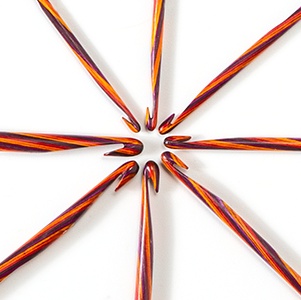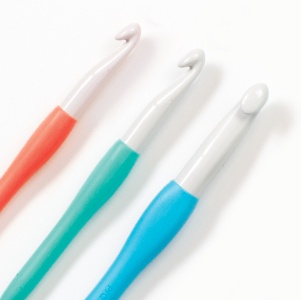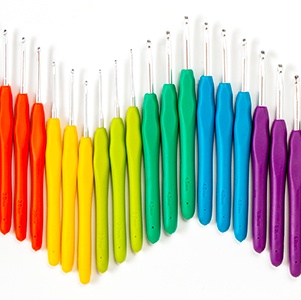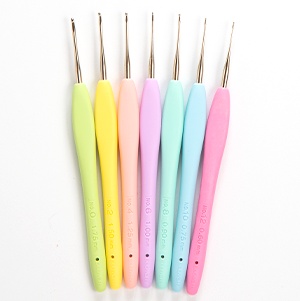
The Hook
If you’re new to crochet, you may wonder why there are so many different types of crochet hooks... and how do you figure out which one to use? The answer is simple: one size does NOT fit all—every crocheter is different. We each crochet in our own unique way, and we make a variety of different projects.
Let us help you choose the right crochet hook for you!
Anatomy of a Crochet Hook
- 1. head: the point of the hook
- 2. throat: the inner part of the hook
- 3. shaft
- 4. grip
- 5. handle

Which Hook Should I Use?
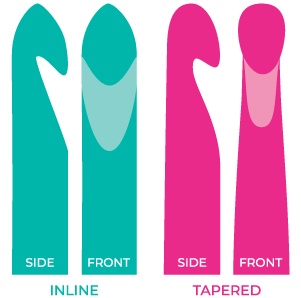
Crochet hooks typically fall into two different categories: and crochet fans usually have a preference for one or the other. Often, this preference is as simple as liking the type of hook you used when you learned to crochet.
Inline Hooks often have pointy heads that are the same size as their shafts, which are shorter in length. Some crocheters feel that the shape of an inline hook helps create uniform-sized stitches and contributes to more consistent tension.
Tapered Hooks often have a rounded head with a smaller throat than the shaft and longer shaft length. Some crocheters find it easier to get the head through stitches and like the additional length for extra crochet mobility..
It all comes down to your personal preference. We suggest experimenting with both styles of crochet hooks to see which suits you best.
The Hold
How Do I Hold My Crochet Hook?
There are many different ways to hold your crochet hook. The way YOU choose will depend on the type of crochet project you’re working on as well as what’s comfortable for you. Most people choose from two main grips:
The Pencil Grip Your hook is held like a pencil, with a three-fingered pinch. (shown in the top image)
The Knife Grip Your hook is held like a steak knife, with your last three fingers controlling the motion of the hook. (shown in the bottom image)
We’ve covered the main two ways to hold a crochet hook here, but there are several more. As you progress in your crochet journey, you will find that some grips are more effective for certain types of crochet than others. Keep in mind that there is no right or wrong way to hold a crochet hook—find what works best for you!
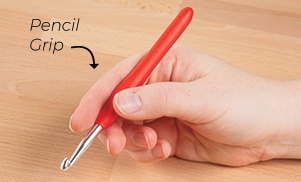

The Size
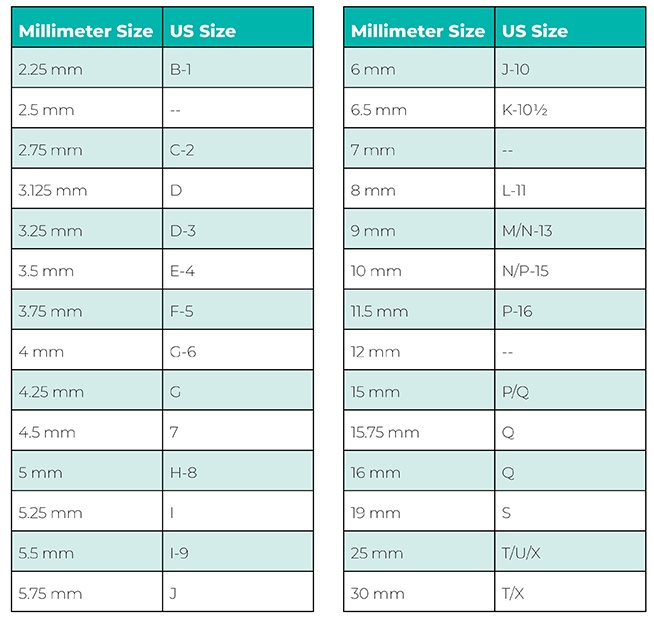
Crochet Hook Sizes
Crochet hooks are measured in millimeters (mm), but also have a corresponding letter from the alphabet and/or number (US size), though these can vary depending on the manufacturer.
Different hook sizes can be chosen for different purposes. If you want your crocheted fabric to have an open airy weave, choose a larger hook. If you want your fabric to be dense with minimal holes (like with amigurumi) choose a smaller hook.
Each yarn label usually has a recommendation for what hook size to use with that particular yarn. Use the hook size recommendation as a jumping-off point to help you figure out which hook to use, but do pay attention to the gauge swatch recommendation if you are making a crochet pattern that needs to fit a particular way.
The Material
Wooden Crochet Hooks
Wooden crochet hooks are made of a wood such as bamboo or a composite of dyed wood (like our Radiant Crochet Hooks). Wood is warm to the touch and a little slower to slide than aluminum hooks. They provide a nice earthy feel when you are crocheting, and are a great choice when working with more slippery yarns (especially non-organic fibers like acrylic) because they add some additional grip to keep the yarn from sliding too fast.
Plastic Crochet Hooks
Plastic crochet hooks are often made in brightly-colored plastic. They are inexpensive, readily available, and work with most yarns. Plastic crochet hooks are also lightweight and fairly slippery, and available in many sizes. Most jumbo hooks (commonly used for afghans or rug-making) are made in plastic.
Plastic hooks are great for beginners because of the low price and other features; however, they can sometimes have ridges where the seam of the plastic mold comes together (no problem, just file it off with a nail file), or they can snap if used with heavy yarn or a tight tension.
Plastic crochet hooks’ low price and light weight make them perfect for travel!
Ergonomic Crochet Hooks
Ergonomic crochet hooks have large handles that are easier to grip, and can reduce the pain associated with yarn crafting. If you experience hand fatigue when crocheting, you may find that an ergonomic crochet hook helps! Try WeCrochet Brights or Clover Soft Touch.
Steel Crochet Hooks
Steel crochet hooks are generally used for crocheting with thread or lace weight yarn. The strong steel keeps the tiny hooks from bending while making projects like lace, doilies, and beading.
Note: The numbering system for steel crochet hooks is inconsistent from brand to brand. Refer to the mm measurement when looking for a steel hook.
Crochet hooks are made in additional materials such as aluminum and bamboo. WeCrochet will be expanding their hook inventory soon—stay tuned for product updates!
The Perfect Hook for You
Find the best crochet hooks right here at WeCrochet!
Now that you know some background info about crochet hooks, you’re ready to try them out. There’s no real way to know which hook is perfect for you until you test drive some.
Get started crocheting with our Brights Crochet Hook Set.


